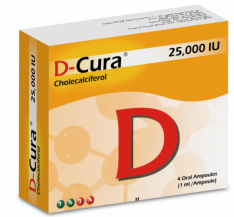
D-CURA 25000 IU Price
Active Substance: Cholecalciferol.
Overview
Welcome to Dwaey, specifically on D-CURA 25000 IU page.
This medicine contains an important and useful components, as it consists of
Cholecalciferolis available in the market in concentration
Name
Cholecalciferol (Vit. D3)
Precaution
People with the following conditions should exercise caution when considering taking vitamin D supplements: High blood Calcium or Phosphorus level Heart problems Kidney disease Vitamin D must be taken with adequate amounts of both Calcium and Magnesium supplementation. When Calcium level is low (due to insufficient vitamin D and calcium intake), the body activates the parathyroid gland, which produces PTH (parathyroid hormone). This hormone kick starts vitamin D hormone production and assists removal of Calcium from the bones to be used in more important functions such as neutralizing body acidity. Lactation: Drug is distributed into breast milk; use with caution
Indication
Osteoporosis, Hypoparathyroidism, Rickets, Osteomalacia,Vitamin D Deficiency, Pseudohypoparathyroidism, Familial hypophosphatemia
Contra indication
Colecalciferol is contraindicated in all diseases associated with hypercalcaemia. It is also contraindicated in patients with known hypersensitivity to Colecalciferol (or medicines of the same class) and any of the constituent excipients. Colecalciferol is contraindicated if there is evidence of vitamin D toxicity.
Side Effect
Generally all nutritional supplements are considered to be safe and well tolerable. However, few side-effects can generally occur including hypercalcaemia syndrome or Calcium intoxication (depending on the severity and duration of hypercalcaemia), occasional acute symptoms include anorexia, headache, dry mouth, nausea, vomiting, abdominal pain or stomach ache and constipation with the administration of Colecaciferol.
Pregnancy Category ID
1
Mode of Action
Vitamin D3 is a fat-soluble sterol. It is necessary for the regulation and regulation of calcium and phosphate homoeostasis and bone mineralisation. Vitamin D is also essential for healthy bones as it aids in Calcium absorption from the GI tract. In addition to this it stimulates bone formation.
Interaction
Increased risk of hypercalcaemia if given with thiazide diuretics, calcium or phosphate. Antiepileptics (e.g. carbamazepine, phenobarbitone, phenytoin & primidone) may increase vitamin D requirements. Rifampicin & isoniazid may reduce efficacy of vitamin D. Corticosteroids may counteract the effect of vitamin D. Digoxin or any cardiac glycoside. Reduced absorption when taken with cholestyramine, colestipol, mineral oil, orlistat. Ketoconazole.
Pregnancy Category Note
Information not available
Adult Dose
Child Dose
Renal Dose
Administration
